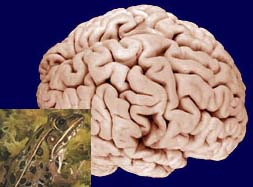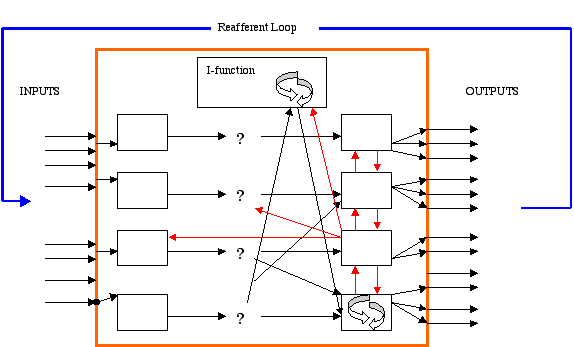Serendip is an independent site partnering with faculty at multiple colleges and universities around the world. Happy exploring!
Brain Behavior Institute - Session 9
|
|

|
BRAIN AND BEHAVIOR INSTITUTE 2008 |

|
Architecture: From the Output Side

- Bipartite : "I-function", nervous system as story teller
I love the story he is developing about the I function and the cognitve unconscious because if you substitute Ego and Id (and make a few adjustments in definition) it seems to me you have pretty much the same thing ... Carol
We've established that pain occurs in the brain, not at the perceived site of the pain. That doesn't say that the stimulus that brings about the pain response also takes place in the brain. The stimulus may, indeed, originate at the perceived location (or at any site along the path to the brain) ... Alan
What happens when you tell a paraplegic person to imagine themselves walking. Does their brain fire in the same way as it used to when they walked? Do paraplegic people have dreams of walking? Do those patterns (in dreams or thoughts) become more and more diffuse over time? ... Adi
students that do not follow directions the first time given have a disconnection in their nervous system that implies that the auditory neurons are not sending the message or information through for any action to follow? Is their cognitive unconscious disabled or disjointed etc? Or is it the time gap for the I-function to respond to the stimulus that is causing the slow response? Or better still have they turned their I-function on very actively? ... Tola
Sometimes the I-function does get in the way of learning but the lack of the I function would make us act like the frog ... Our I function makes us think that we are not being risky or spontaneous but ...... Just by coming to this workshop is a risk because it changes the way we think about teaching and the way our students learn ... Judith
My 18 year old son will take more risks than I will like to imagine. Think of any situation from driving, investing in a business, traveling at night, going on the most tumultuous ride in a theme park just to mention a few. To make a connection with today's discussion topic, my son's I-function is suppressed most of the time when he engages in these activities whereas mine is "over" activated ... Tunde
The I-Function gets stronger with age advancement while the cognitive unconscious gets weaker ... Tola
as I teach I should encourage students to be active in using their cognitive unconscious. It would help students to learn and be more creative ... Bernadine
Try to tell a piano teacher for instance, that directing the student to use drills, memorize notes or practice musical pieces over and over again will inhibit their creativity. Actually this training is stimulating the brain, creating a more complex neural structure and developing muscle memory that will eventually ENABLE their student to take off into all aspects of the student's chosen direction of creative process! ... Joyce
the I Function helps us to make decisions where as the cognitive unconscious allow us to use our creativity. How do we get our students who mainly use their I Function to make unwise decision, example a boy loses his life by climbing over two fences to get a hat at a theme park or pulls fire alarms in school, how can they be trained to use their cognitive unconscious to discover and design? ... Seta
the students I work with are primarily grade levels behind where they should be, come from rough neighborhoods and low-income households with little to no parental involvement. These students need to be taught to conform to rules or they will not survive in the ‘real’ world and unfortunately the only place they are receiving this lesson on compliance is at school… Their creativity is not being stifled by this lesson in compliance, they are being given tools to compete with the students they will be up in classes with when they reach college ... I have worked in suburban schools where students receive lessons in compliance at home and when they come to school (generally) they demonstrate respect and cooperation. Perhaps in these cases, student’s creativity is being stifled when they are taught compliance in school ... Sage Brain and education extended
Moving on - Additional architectual principles from looking at the output side ...
- Motor symphony
- Central pattern generation
- Gene/environment interactions
- Corollary discharge - role of motor control in perception
- Distributed control, who's running the show?
- Output associated with "expectation" or "model"
- Input as test of expectation/model
- Brain as explorer/scientist
- Action without "thinking", "I-function", story teller - preferable in some circumstances
- Purpose, expectation, creativity, exploration without "thinking", "I-function", story teller
- Damage to neocortex in humans leads to "paralysis"
- Loss of "willed movement"
- Loss of inhibition
- Motor cortex - "I-function"?
- I-function as a way to conceive new things?
Your thoughts in forum ... new understandings/questions? Relevance of all this to classroom?



Comments
group process: symphonies and jazz
Motor Symphonies
In my opinion children of all ages respond to modeling (good or bad) and students expect the teacher to model in the classroom. I think we have a huge effect on the tenor of each class regardless of each student’s priorities. I believe in the conductor of the classroom symphony not in a lecturing, preachy way but rather the attempt of the conductor to draw out the best in each student.
I found it quite interesting when Paul remarked today that a jazz band needs no conductor. This struck a ‘cord’ because last year I had quite a few ADHD students who needed to move and talk constantly. When I discussed these students with administrators l would often refer to them as my ‘honking horns’ because they produced loud discordant notes in a smooth environment.
I love jazz music but want a beautiful symphony in my classroom. My opinion is that there is a way to conduct it.
organizing emerges without a hierarchy
Central Pattern Generation
Since we are seeing and accepting evidence that the motor system has stuff stored up in the central nervous system then we can as well conclude that the brain is to blame for every action or behavior of individuals.
It looks like external forces do not play a serious role in the behaviors exhibited as such. But what about children that do things they saw an adult doing? Is it that they already have this in them and just got activated by seeing someone do it?
Compliance
Compliance is perrhaps a poor choise of words. Pro-social behavior which is an aspect of compliant behavior may be more appropriate. Children need boundaries in order to function in a group. In order to learn in a school setting kids need to internalize what works in that environment. School rules and home rules are at times in conflict.
In kindergarten, students need to be gently encouraged to learn the value of pro-social behavior. These lessons are important to learn at this point in their education as a foundation for future teacher-student relationships.
"social behavior" as opposed to "compliance"?
Post new comment